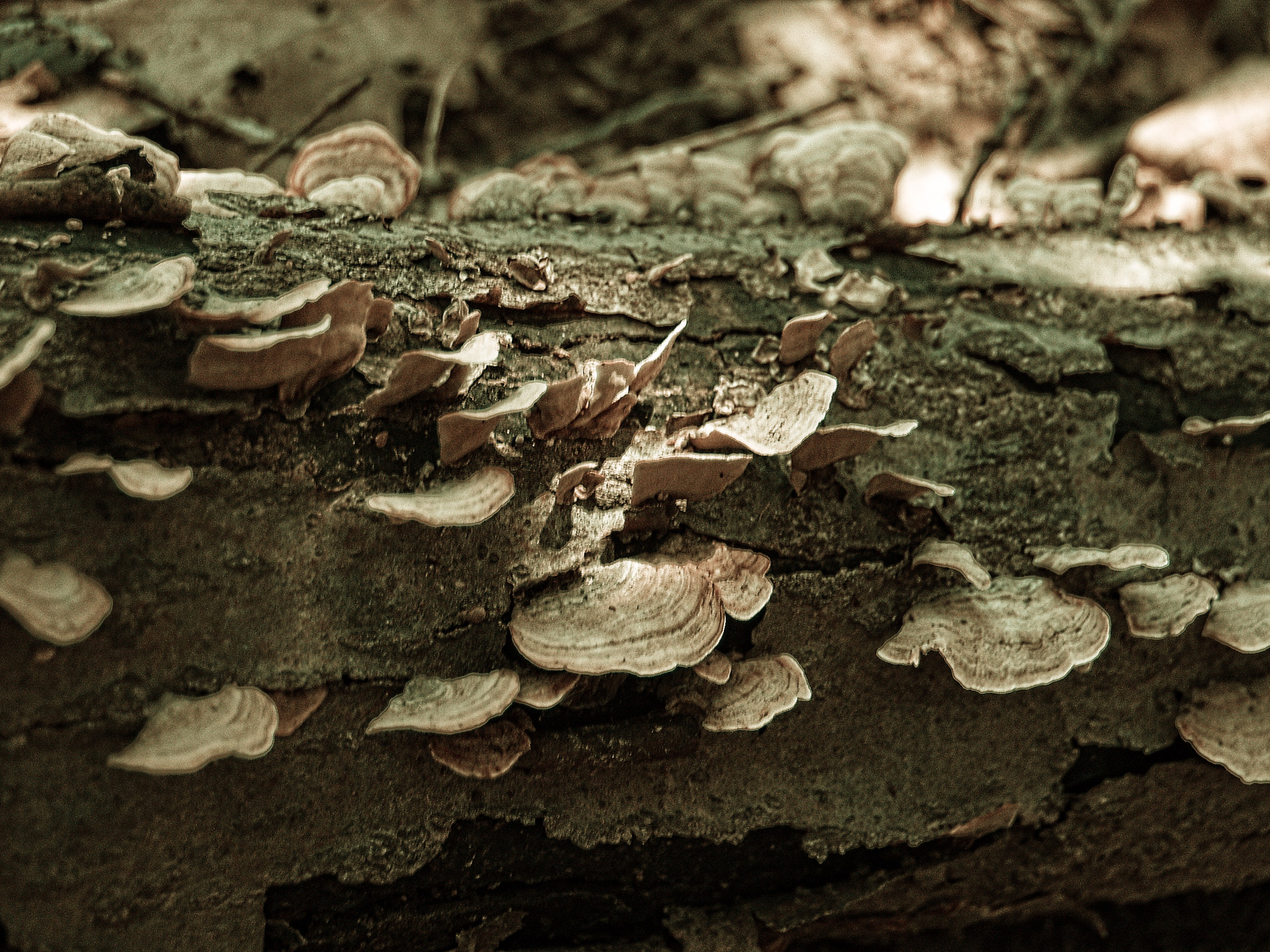 This frog in the pond at the Homewood Cemetery is looking at us, and knows we are looking at it.
This frog in the pond at the Homewood Cemetery is looking at us, and knows we are looking at it.
-
Frog
-
Shelf Fungus
For no very good reason, Father Pitt decided to see what this picture of a log covered with little bracket fungi would look like if it had been printed with one of the limited-color processes sometimes used for books of popular science in the 1930s. There is actually a plugin for the GIMP that imitates two-color Technicolor, which suited his purposes well enough. What do you think? Would this not have made an admirable illustration in The Child’s Book of Wonders of the Fungus World?
Camera: Olympus E-20n.
-
Decorations on the Rear of the Westinghouse Memorial

The Westinghouse Memorial is one of our best works of public art, and the thoroughness of the execution is one of the best things about it. It is meant to be seen from the front, but if you wander behind it you will find, not a blank wall, but lovingly detailed bronze decorations that almost no one ever sees.
Camera: Olympus E-20n.


-
207 Shiloh Street, Mount Washington

Instead of one obvious central business district, Mount Washington has several small business districts, of which the densest and perhaps most interesting is the one that takes up two blocks of Shiloh Street just off Grandview Avenue. Several of the buildings show a decided German influence, and this one (built in 1893) is a particularly good example of what we might call South Hills German style. (Before the First World War, the back slopes of Mount Washington were known as the “South Hills”; Beechview and the neighborhoods farther south were described as “beyond the South Hills.”)
Like most of the buildings on Shiloh Street, it is irregularly shaped, a long trapezoid with its street front on an oddly-angled short side of the building.
This is an enormous composite picture; be prepared for nearly 20 megabytes of data if you click on it.
-
Tiny Mushrooms
There are mushrooms that decompose whole tree stumps, and there are humbler mushrooms whose job is to decompose twigs. Somebody has to do it.
Camera: Konica Minolta DiMAGE Z3.
-
Two PNC Plaza
Seen from the Smithfield Street side of the plaza. The “plaza” itself could have been a distinctive and beautiful urban space, but poor and seemingly random planning—of which the intrusive parking-garage entrance here is a good example—has marred it.
Earlier we published a view of Two PNC Plaza from the Liberty Avenue side.
One response
-
May Building

Built in 1909, this is a typical small Beaux-Arts skyscraper. Its base has been unsympathetically modernized, and perhaps at the same time it grew an ugly parasitic infestation in the rear; but the basic shape of the building is still intact.
-
Mushrooms on a Stump, Frick Park

KONICA MINOLTA DIGITAL CAMERA Continuing our mission to document a season of flourishing mushrooms, we present Mushrooms on a Stump, part of an enormous colony growing on a stump in Frick Park.
Camera: Konica Minolta DiMAGE Z3.

KONICA MINOLTA DIGITAL CAMERA -
Interior of Saint John Lutheran Church, Carnegie

Saint John Lutheran Church in Carnegie is a fine Gothic building from 1929, late in the Gothic Revival, when it was possible to build a Gothic church with a faint whiff of Art Deco in the exterior. The interior is simple Gothic, but with some very elaborate woodwork, especially in the splendid reredos. This wide-angle view, taken from the balcony, was put together from three photographs.
-
Former Lazarus Department Store

There is some sort of lesson in this building, and if it were possible to figure out what it is, we could all learn the lesson and never make a wrong decision again.
Briefly, the story is this: Lazarus bought Horne’s, one of the last independent department-store chains in America, and for a short time operated out of the old Horne’s building. But Mayor Murphy (a man whom Father Pitt considers the progenitor of most of the good things that have happened in Pittsburgh in the last two decades, but a man who also made a few mistakes) had a grand plan to rebuild Fifth Avenue completely into a new retail district that would draw suburbanites back downtown. Somehow Lazarus was persuaded to build an entirely new store here, which opened to much fanfare in 1998.
Mayor Murphy’s plan was ultimately scuttled by various forces, including preservationists; but the long uncertainty emptied all the tenants out of what had been one of the country’s busiest retail streets. (The uncertainty was not alone to blame, of course: Mayor Murphy’s drastic plan was in response to an already pronounced drop in downtown retail business.) Five and a half years after it opened, the new Lazarus closed, and Fifth Avenue below Kaufmann’s (now Macy’s) was practically deserted.
What lesson do we learn here? Certain conservative think tanks preached the lesson that government involvement in redevelopment never works. Plainly that is false; Pittsburgh can point to dozens of examples where similar public-private partnerships have flourished. Whether it is a good idea for the government to do those things is a completely different question, and one we can happily debate forever; but the failure of Lazarus does not disprove government.
So what is the lesson?
Perhaps the lesson, in this as in so many other things, is that timing is everything. The new Lazarus was going up just as Pittsburgh’s department-store-based retail district was floundering—and it was floundering because department stores themselves were floundering. There is not a big city in the United States that did not lose department stores in the years around the turn of the twenty-first century; yet somehow the retail planners convinced themselves that downtown Pittsburgh could happily support four huge department stores. If Lazarus had held out in the old building another ten years, though, what might have happened? By 2008 the downtown revival was definitely on the way; now downtown is crowded with suburbanites on weekends, and the crowds tend to collect around the Diamond and the Cultural District—both very near the old Horne’s.
Well, we’ll never know. But this particular building, though it failed as a department store, is a very attractive addition to the urban landscape; so it is cheering to report that it is now home to restaurants, offices, shops, and some apartments in the upper floors. Fifth Avenue is coming back.




